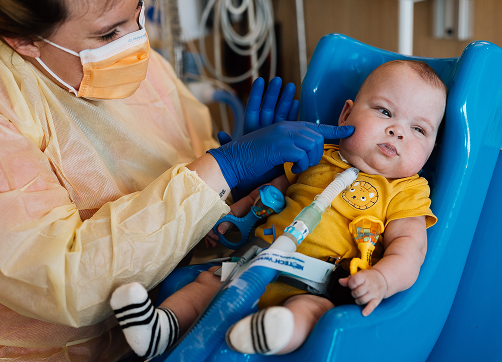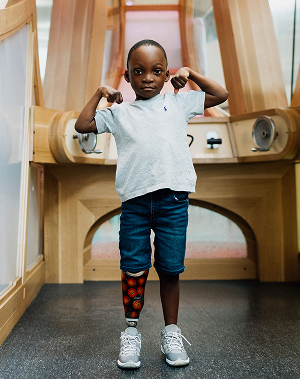hip dysplasia


about condition
Developmental dysplasia of the hip (DDH) is a problem with the way a baby’s hip joint forms. Sometimes the condition starts before the baby is born, and sometimes it happens after birth, as the child grows. It can affect one hip or both.
Most infants treated for DDH develop into active, healthy kids and have no hip problems.
what is hip dysplasia?
The hip joint is a ball and socket joint. The ball or top part of the thighbone (femur) sits inside a socket (acetabulum) that’s part of the pelvic bone. The ball moves around in different directions, but always stays inside the socket. This lets us move our hips front, back, and side to side. It also supports our body weight for walking and running.
In DDH, the hip does not form correctly. The ball part of the joint may be completely, or partly, out of the socket. Sometimes the ball part may slide in and out of the socket. Often, the socket is shallow. If this is not fixed, the hip joint will not grow like it should. This can lead to pain with walking and hip arthritis at a young age
what causes DDH?
There may be a few reasons why a child develops DDH. They could include:
- Babies in the womb in a breech position are found to have a greater incidence of DDH. These are babies that are buttock side down instead of head down.
- A small or tight uterus (womb) because there is less room for the fetus to move. This is seen in first-born babies and babies born to a mother with low levels of amniotic fluid during pregnancy.
- Children born with other conditions, such as metatarsus adductus and torticollis, also have a higher risk of DDH.
- A genetic component can be involved, as it can run in families.
- Babies that are swaddled tightly with their legs together and hips and knees straight have a higher risk of developing DDH after birth. Babies need to have plenty of room to move, even when swaddled.
what are the signs and symptoms of hip dysplasia?
Developmental dysplasia of the hip doesn’t cause pain in babies, so it can be hard to notice. Doctors check the hips of all newborns and babies during well-child exams to look for signs of DDH.
Parents could notice:
- The baby’s hips make a popping or clicking that is heard or felt.
- The baby’s legs are not the same length.
- One hip or leg doesn’t move the same as the other side.
- The skin folds under the buttocks or the thighs don’t line up.
- The child has a limp when starting to walk.
Babies with any of these signs should see a doctor to have their hips checked. Finding and treating DDH early usually means there’s a better chance for a baby’s hips to develop normally.
when does DDH develop?
Developmental dysplasia of the hip often starts before the baby is born and is present at the time of birth. Other times, it develops as the child grows and develops during the first year of life.
DDH is present in 1 to 2 out of 1,000 babies and is more common in females than in males
how is DDH diagnosed?
All infants are checked for DDH. Physical exams of the baby are done at birth and at well-child visits. The pediatrician or family doctor looks for differences in leg lengths, decreased hip motion and symmetry in skin folds on the thighs and buttocks. The doctor performs specific tests on the hip joints to see if they are loose or unstable.
Providers may also do imaging tests to diagnose.
- Younger than six months old: An ultrasound is used to see the joint. This is because their hip joint is mostly cartilage, not bone.
- Older than six months: An X-ray is used to see the bones of the hip joint.


treatment
Treatment depends on the child’s age and the severity of the condition. It focuses on keeping the ball in the right spot in the socket so that the hip joint can develop normally.
Infants up to six months of age are placed in a soft brace called a Pavlik Harness. This harness allows the baby to move his or her legs while keeping the hip joint properly aligned. Typically, the harness is worn 23 hours per day for 4-6 weeks and 12 hours per day (nights and naps) for 4-6 weeks. If the harness is not enough to keep the joint in the right place, a brace made of a harder material may be needed.
In some cases, a hard cast may be used. If these methods are not successful or if the child is diagnosed at a later age, surgery followed by casting may be required to realign the hip joint. Children will continue to be monitored as they grow to watch for continued proper development of the hip.
what would happen if DDH is left untreated?
An early diagnosis of DDH yields good long-term outcomes for the child. When found early and treated, children will develop a normal hip joint. However, if DDH is diagnosed later in life or if left untreated, it can lead to pain, a difference in leg lengths and arthritis in early adulthood.
faqs
Following surgery for DDH to manipulate the hip bone into place, the child will be put into a spica cast for 6-12 weeks to help stabilize the hip and ensure proper development of the hip joint.
A spica cast is a cast that begins below the chest and extends down the hips and legs. The child will not be able to bend at the waist and there may be a bar that goes between their legs.
Children who are potty trained may regress slightly in a cast so it’s important to use a diaper, just in case! For a short time, surgery and pain medicine may affect the ability to feel the normal urge to use the bathroom.
For children who are potty trained, it may be necessary to use a bedpan. To keep the back part of the cast dry when using the bedpan, it is helpful to use a disposable diaper tucked in the back of the cast.
To do this, turn the child on their tummy. Place the edge of the diaper in the back of the cast. The absorbent side of the diaper should be next to the child’s skin. Then, fold the rear of the diaper up towards the waist so that the plastic is next to the back of the cast. Then, turn the child on their back and slip the bedpan under them. They should be placed on the bedpan so that the head is higher than the buttocks to keep urine from going up in the cast. When finished, gently roll your child onto his/her side, remove the bedpan and diaper and wipe skin dry.
For children not yet potty trained, you must tuck the diaper inside the cast opening with the plastic side next to the cast and the absorbent side next to the skin. Do not put the diaper on the outside of the cast. Change the diaper as soon as it becomes wet.
You may need to get up for diaper changes at night.
It is very important that the cast stays dry. Sanitary napkins (whole or cut in half) or urinary incontinence pads may be placed in the diaper for added absorbency. Do not cut diapers in half to make them smaller. This can make a gel-like substance form inside the cast when the loose diaper pieces get wet. The cast will most likely be filled with a water-resistant liner that can be gently cleansed with a wet rag or diaper wipe.
Physical therapy will show you how to carry your child safely when they are in a spica cast. In most cases, you will be able to position your child on your hip or carry them with a fireman carry.
While in a spica cast, many children can use their regular car seat. The inpatient physical therapist will evaluate your child and your car seat while in the hospital. They may also recommend or fit a different car seat or an EZ-ON vest made out of seatbelt material. In rare cases, if a child cannot fit into a car seat or an EZ-ON vest, ambulette transport may be arranged for child transportation.
here when you need us
description:
Whether you’re looking for the right provider, ready to make an appointment, or need care right now—we’re here to help you take the next step with confidence.
